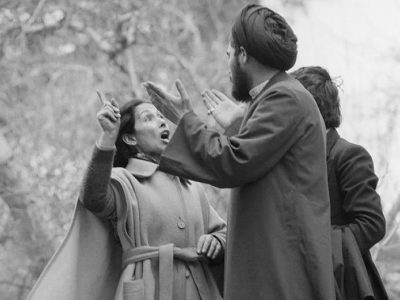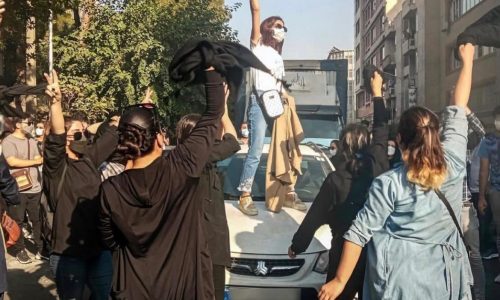What’s With the Veil?
What’s left to say about the veil?
After all these years, one would have thought very little. But apparently, there’s still much ground to cover. As proof of its eternal relevance to the times, because our times are always tortured, here it is again, in Iran, at the forefront of the country’s existential angst.
And the hijab stands so, a full half-century after it began to don many Middle Eastern women’s head. It’s everywhere, transcending neighborhoods and sect and class and borders. By any measure, at first look, it has won. It has won the religious argument, the cultural one, the social one, and certainly the political one… And it has done so across systems. In states that don’t impose it by law, those who veil are a solid, even overwhelming majority. The women who, for whatever reason, love it have all the freedom to flaunt it; and many of the women who are totally indifferent towards it or hate it have no choice but to wear it.
You would think that decades into this sweep of the scene in theocracies and so-called secular states alike, the hijab would have long ago eased itself confidently into the fabric of our life. You would think its proponents, victory in hand, would have been able to sit back and bask in their remarkable feat. But throughout the years, the hijab never became the unquestioned, even banal, presence its proponents have incessantly pushed for it to be. Paradoxically, even as it spread, perhaps beyond their wildest dreams, it remained a contested issue in our fraught politics.
This truth is as telling as it is obvious; so obvious in fact that we haven’t really bothered to ask why does a symbol so powerful, so dominant, so matter-of-fact, in largely conservative, patriarchal societies continue to be this controversial?
There isn’t one answer to this question, but here’s a compelling one the hijab’s supporters have refused to countenance: weaponized, made legally or effectively compulsory, and deployed as part of a larger package of norms and policies and laws, all meant to enshrine women’s subordinate role in and out of their abodes, the veil was denied its life of normalcy as a matter of free choice. This, of course, in unsettled societies and insecure authoritarian regimes where such legal restrictions and social intolerances only added to the generally oppressive mood.
In revolutionary Iran, where Khomeini took the regional lead in 1979, the blanket enforcement of the hijab in 1983 came, in fact, on the tail end of a series of directives that started almost immediately after he took hold of the country. Very soon after his triumph, Khomeini suspended the Family Protection Law and prohibited women from leaving their home “without [their] husband’s permission, even to attend [their fathers’] funeral,” halted their appointment as judges, froze them out of the army, informed the married ones they could no longer attend regular high school, declared divorce solely the man’s prerogative, enforced the veil in the workplace, segregated sports, banned mixed schooling, shut down daycare centers, and exhorted working mothers to be the housewives they were born to be. In 1982, he reduced the marriage age for girls from 18 to nine. It took 20 years for the Islamic republic to raise it again to 13.
The achievements of Iranian women over the past five decades can only be fully appreciated in the context of this history of severe infringements on their space and place in society, indeed on their humanity. Against daunting odds, they are a solid majority of university graduates and students in Medicine, Basic Sciences, Humanities and Arts, and Experimental Sciences, they boast over 400 writers and lead in the best seller category, and have even managed to win back the right to act as deputy prosecutors in a profession viscerally hostile to them. And every single time the clerical regime launched a modesty or morality campaign, it failed and had to retreat largely because of female defiance.

Such has been the success of Iran’s finer sex that the Islamic Revolutionary Guards Corps’ political bureau issued a report 16 years ago that classified feminists along with “mystics, dervishes, devil worshipers, journalists, bloggers, secular students and intellectuals, reformists, as the main threats to the national security of the country.”
So there is little that really surprises in the current eruption of Iranian women. It is very much in character. What makes this latest unrest so significant is not because they have made the veil the centerpiece of discontent, although the boldness of this move cannot but impress. What makes the moment of potential consequence is the apparent disaffection on the part of many in the regime’s camp, women among them. If this restlessness is indeed more than anecdotal, then it suggests a recognition that social strictures have become a drag on an Islamist revolution that has lost much of its appeal and legitimacy in an already secularized society. The opposition, among them longstanding reformists, have long known this. That the system’s own avowed followers are catching up signals, perhaps, looming shifts at the heart of the system.
When Iran led the Islamist trend in 1979, it helped set the tempo and trajectory of the ensuing decades in the region. Islamism, already rising in many a “secular” Arab country, became, in influence, second only to the state itself. In 2022, with Islamism now as spent as all the ideologies that preceded it, one has to wonder if Iran will be leading the pack in the opposite direction.
The Iranian regime is not going anywhere. This police state has entrenched itself in every nook and cranny of the country. It is very violent and has no qualms about shedding much blood in quelling dissent. But this is not to say that the clerical order itself is staying put. And if Iran does indeed pivot, then we will be witness to one of the Middle East’s most intriguing counter-trends.
And here’s the thing: whereas Saudi Arabia, by orders at the top, has already begun its pivot, Iran’s will have been carried out with much prodding from below.

****
On Another Note
I am hearing tick-tock every time I read about Israel and the Palestinian Occupied Territories. I have a foreboding that we are on the precipice of cataclysmic events. Comes now this profile in Jewish Currents of Kahanist Itamar Ben-Gvir to reinforce my jitters. Here’s a peek:
It was, like much of Ben-Gvir’s rhetoric, partially an act of trolling. For the followers of Meir Kahane—the American-born rabbi who became the leader of an armed, far-right theocratic and racist movement in Israel—Ben-Gurion, a secularist and socialist, has long represented not a hero worth emulating, but an ideological foe. Yet Ben-Gvir’s video was also a challenge to the Israeli center and center-left, which has sought to label him as beyond the pale of acceptability. By comparing himself to Ben Gurion, Ben-Gvir asserted that he and his party are not a deviation from Zionism’s founding spirit but its authentic continuation.
Very soon now, Israel and Lebanon will be co-signatories to a maritime deal. Israel is very keen on it in order to start cashing in on the gas reserves. Lebanon is even keener because therein, it thinks, lies not only new treasures to thieve but the door to yet another miraculous escape. Most Lebanese forget that their country was once at the nexus of the Arab world’s rising oil economy. In fact, the 20th century’s good times were largely due to this link. In Synaps, Zachary Davis Cuyler revisits this “golden age” and warns of the pitfalls. It’s a fascinating read:
Yet that golden age also laid the foundations of Lebanon’s ongoing collapse, fueling an economy built on speculation, rent extraction, and import-based consumerism. This moment left plenty of physical traces: from a deeply rooted car culture to the rusting refinery north of Tripoli, through to the corporate headquarters that still stand amid Hamra’s darkened skyline.
